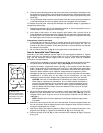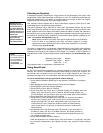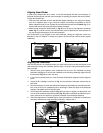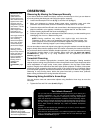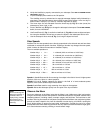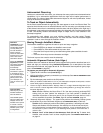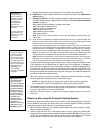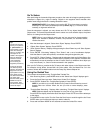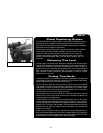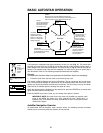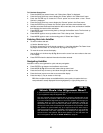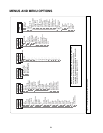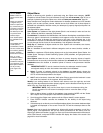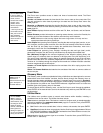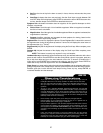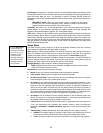
21
LX90 Tips
Fig. 9: The GPS Receiver.
GPS
Receiv
er
The Global Positioning System
The Global Positioning System (GPS) is comprised of 24 satellites orbiting
the Earth that are constantly transmitting their precise position and time.
The system provides highly accurate, worldwide positioning and navigation
information for any number of applications.
GPS receivers on the Earth acquire signals from three to twelve satellites
to determine the precise latitude, longitude, and time of the receiver.
(Accuracy of the receiver's position may be within 10 to 15 feet.) As
AutoStar uses latitude, longitude, and time information to calculate the
positions of celestial objects, GPS is an ideal tool for aligning your
your
telescope.
Detecting True Level
To detect level of the base of the telescope, AutoStar must calculate the tip
and tilt of the telescope at three compass points and then compensate for it.
Finding level involves the geometric calculations of a "plane." In order to
define a plane, three positions are necessary. This is not unlike building a
table: For a table to stand level and solid, it must have a minimum of three
legs. AutoStar makes gravitational measurements to make a precise
determination of true level.
Finding True North
Locating True North is one of the most important ingredients in the alignment
of a telescope.True North is the axis—the pole—which the Earth spins about
and is a k
ey reference for the motion of the Earth.
As you look at the night sky, the stars seem to move; in fact, if you watched
long enough or took a long time-e
xposure photog
r
aph, y
ou'd realiz
e that the
stars seem to revolve around one point—the pole or True North. When
AutoStar knows where True North is and also knows the time, it can calcu-
late the location of all the other objects in the sky.
One tr
aditional way to find True North is to locate the North Star, Polaris,
which lies very close to True North. Another way to calculate True North is to
use gyroscopes or accelerometers.
LX90's determine True North by using a magnetic North sensor. The sensor
locates magnetic North. Magnetic North is not True North, but a measure-
ment of the magnetic lines of the Ear
th. Magnetic North may deviate several
degrees from True North. But AutoStar, using the observation site location
determined by the GPS and magnetic North information, can calculate the
position of True North.
Some areas are subject to magnetic disturbances, and the magnetic field of
the Ear
th changes slightly from y
ear to year.AutoStar allows you to adjust for
discrepancies in the local magnetic field using the "Calibr
ate Sensors" option
in the Telescope menu. See page 29 for more information.



